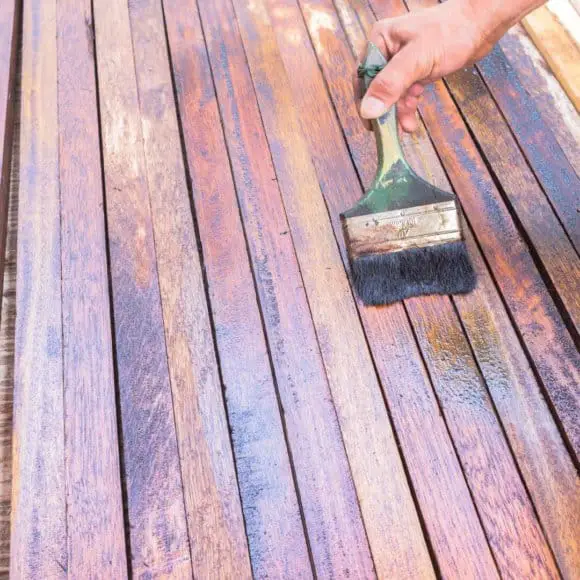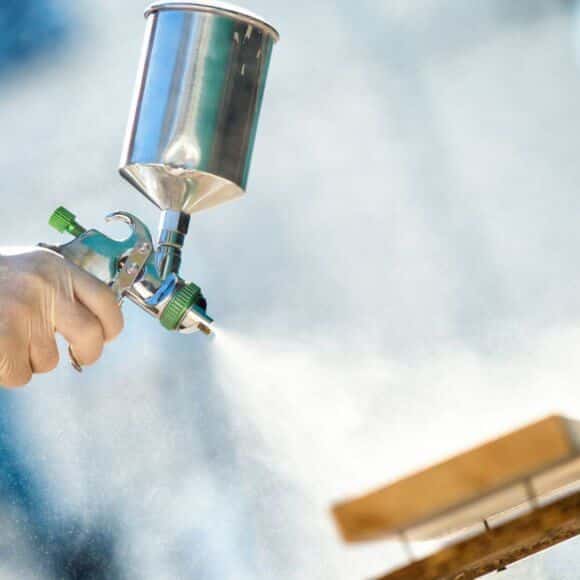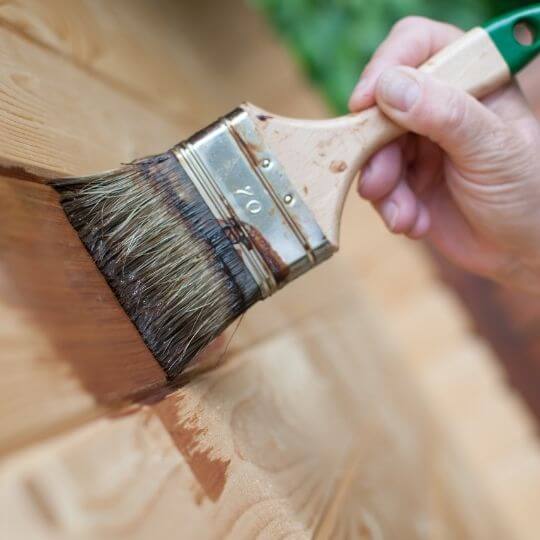If you are in the middle of some home improvement tasks, you will definitely need to know more about Thompson’s water seal. Today, we will cover the specifics of this material and answer the main question: Can You Paint Over Thompson’s Water Seal?
Thompson’s Water Seal is one of amazing the products many households use to seal and protect their exterior or interior surfaces from sunlight. However, if not used under specific instructions and guidelines, it won’t work. If you don’t wish to hire a plumber and spend extra costs on professional assistance, our article will help you to do it yourself. [1]
What is Thompson’s water seal?

First, let’s discuss what a Thompson water seal is and how useful it is.
When it comes to protecting your home from natural disasters, no one offers protection quite like Thompson’s Water Seal.
The Thompson Clear Multi-Surface Sealer is designed to be waterproof so that you can protect your various furnitureagainst water damage. It protects decks, fences, and other wood structures, and it also creates a barrier over brick and concrete to keep your driveways, patios, and walkways looking great year after year.
When it comes to wood, Thompson’s protection knows no bounds. Deck stains come in two varieties: Thompson’s WaterSeal Wood Sealer, which gives your deck a clear, protective coating, or Thompson’s WaterSeal stain, which enhances the colour of wood with a variety of colours. Be sure to pay attention to the type of stain to determine if a transparent, translucent or solid stain is best for your project.
Thompson’s water seals have been reformulated to be more durable than standard waterproofing products, continuing to waterproof and prevent water damage long after other products begin to fail. It penetrates deeper into the surface and repels more water than traditional clear water repellents. If application instructions and coverage guidelines are followed, it can provide years of effective water repellency. [2]
Price and Coverage of Thompson’s water seal
The best thing about this material is its affordable price. Thompson’s Waterseal is available at a very fair price and is available in a variety of bottle sizes. You can buy this model in a 1.2-gallon capacity, and you can also find it in multiple packages to accommodate different deck sizes.
Thompson’s WaterSeal is available in a variety of capacities to suit your deck size. Therefore, it is best to discuss the best surface to treat to achieve the desired coverage. According to the manufacturer, you can continue to use water seal on:
- External wood structure
- Fence
- Deck
- Wooden furniture
The type of wood you choose to treat will not affect performance, and you can expect good coverage of 200-400 square feet per gallon. Also, you only need to apply a thin coat, and it dries faster.
How to apply Thompson Water Seal

Thompson waterproofing products are DIY-friendly and easy to use, but knowing some best practices can greatly improve your results. Here are some tips to help you get better results.
First, selectively apply your Thompson water seal when ambient application and drying temperatures are in the range of 50 to 95 degrees Fahrenheit. If the ambient temperature is in the 50°F range, consider using a clear sealant. If no rain is forecast for at least two days, the water seal will manage to dry well. So, I’d recommend you check the weather and plan your work accordingly.
Besides that, consider installing Thompson waterproofing on a day when the weather still provides the best results.Always allow your wooden deck to dry completely before installing Thompson waterproofing. Using damp wood will result in longer drying times or might not work correctly at all. [4]
Can You Paint Over Thompson’s Water Seal On Wood?

Even though Thompson’s water seal is super useful and convenient, you will need to consider several essential things to let it work efficiently. It is not recommended that you paint over Thompson’s Water Seal. The hydrophobic nature of the Water Seal can even negatively affect the adhesion of the paint applied to it.
The seal is designed so that any type of liquid that falls on the seal will rise and prevent it from penetrating or sticking to the wood.
The water seal is very smooth and allows things to move on it without sticking to the surface. So, if you use paint over the water seal, the same will happen: it simply won’t stick.
If you try to paint over a sealer, it will basically push the paint away from the wood when you try to apply it.
Your paint will also have a hard time penetrating the sealant and basically only cures on the part. This means it will eventually fall off. [5]
Can You Use Thompson’s Water Seal On Painted Area?

What about the opposite combination? Can you use the Thompson’s seal over the painted area? So, Water seal or paint first? Actually, none of these combinations is effective. You don’t want to use the sealer directly on the painted area either. Water Seal should only be used on bare and uncoated brick, deck, stone or concrete. Otherwise, you risk the sealerdripping and not being absorbed by the wood.
If the paint had been first installed fifteen years ago, it would have been a lot easier for you. But what if you are in a rush? How can you get your surface painted but meanwhile protected by the sealer?
There is no ultimate solution to use Thompson’s water seal over the painted area. You can only remove the paint and then apply the sealer.
How To Remove Paint From Wooden Surface To Prepare For Thompson’s Water Seal
Below we will break down the steps you need to take to remove the paint from the area and apply a Thompson water seal.
The first step in this process is to gather the supplies you need.
You will need a paint remover, pressure washer, power sander, and some general maintenance supplies.
The process will take some time, but you will be delighted with the results in the end. [6]
- Ensure the Wood is Worth Stripping
Some woods, especially trimmed woods, look so worn or rotted that there is little to paint when they are stripped. Before you remove old paint from potentially worthless wood, try a few tests to see if your labour is worth it.
- Remove Caulk and Hardware Nails And Screws
Remove all the caulk and hardware from the wood. Cover any non-removable non-wood parts with protective tape.
Take the time to evaluate the condition of the wood and the results you want.
Once you’ve decided to use a paint remover, always take proper safety precautions when handling the paint remover and make sure you choose the correct product.
- Apply Paint Stripper
Concentrating on a small portion at a time, apply the remover liberally with the brush.
Let the product stay on the wooden surface for at least 20 minutes or until the paint blisters and peels. Keep in mind that the solvent may need to sit for several hours when removing multiple layers of paint. Test the paint over time to see if it has softened. Make sure to remove any applied strippers on the same day. Once dry, it is difficult to remove.
- Use A Paint Scraper To Remove Paint
A paint scraper will help you remove as much paint as possible from where the paint remover was applied. Be gentle when scratching; don’t hollow out the wood.
If you feel more resistance than you would like, leave some extra time under the stripper. After removing everything possible with the spatula, you can repeat the process, reapply the remover and do the steps again. If you are satisfied with the condition of the peeled area, continue to the next step.
- Enter These Hard-To-Reach Places
After removing all the paint from the flat sections of the wood section by section, it’s time to work on any raised or recessed areas. Apply the stripper to the wood again and wait at least 20 minutes, but this time use a wire brush to scrape hard-to-reach peaks and indentations.
You can attach a metal brush to a cordless drill for large and relatively flat projects to speed up the process. Be cautiousand do not scrape too hard, as this will leave scratches on the wood.
- Wipe and Sand the Wood
Once you’ve removed those thick layers of paint, you may feel like you’re done. But the last step is really critical. The final sanding and cleaning of the wood help keep the wood free of loose materials such as dirt and debris. Additionally, sanding gives the wood an even surface that can accept paint or stains.
Before sanding, wash the wood in water with a clean cloth, then sand the entire surface. If you can get a power grinder, you can use it for sanding wide, flat sections faster, but you should still hand sand any fragile or engraved sections.
Clean and wipe the surface one more time to remove any particles left by sanding.
Once all these procedures are done, you will have the wood ready to be sealed. It’s recommended to have the wood rested for 1-2 days and then put the sealer on top.
Can You Paint Over Thompson Water Seal On Concrete?
What about the concrete surface? Can you paint over Thompson’s water seal on concrete? Actually, yes. You can paint concrete treated with Thompson’s Water Seal if you follow the correct steps. However, you should not paint over Thompson’s Water Seal Advanced Clear. Proper concrete preparation and adequate drying time are required before painting can begin.
Apply Thompson’s Water Seal to concrete that has been cured for at least 30 days. Apply sealant only after the temperature exceeds 40 degrees, and the surface has been protected from moisture for at least 24 hours.
Let the first layer dry for about 48 hours, then see if a second coat is needed. Put a little water on the concrete. If water beads form on the concrete, seal it. A second coat is required if the water absorbs and creates a dark stain on the concrete.After that, you can paint it over. [7]
How To Remove Thompson Water Seal?

So we discussed how to apply the Thompson water seal on wood or concrete. But what if we need to remove it? How can you remove Thompson’s water seal?
We’ll start with the easiest removal solution. Although you will have to spend some money this way, this is by far the most effective way to remove Thompson water seals from wood.
ESHC Hydrocarbon Cleaner degreaser
You should buy a degreaser called ESHC Hydrocarbon Cleaner and Degreaser. This great product is completely biodegradable, natural and eco-friendly.
It works by its special formula breaking down Thompson water seals on wood, releasing a viscous solution that allows you to wipe the wood and then rinse it off.
ESHC hydrocarbon cleaners and degreasers are acid-free, which means plants and animals won’t be harmed in the process. Use a simple brush to apply the product on the wooden surface with Thompson’s Water Seal and wait 20 minutes for it to work its magic.
After that, you can scrub the surface and spray it with a strong stream of water from a hose or pressure washer. That’s all you have to do to get rid of Thompson’s watermark on wood!
What makes this solution even better is that ESHC hydrocarbon cleaners and degreasers do not affect the pH of wood in any way, meaning you can apply any product immediately after cleaning wood with ESHC hydrocarbon cleaners’ new coating. Cleaner and degreaser.
Because it’s non-toxic, quick-drying, non-flammable and non-flammable, non-corrosive, and completely eco-friendly, it’s the perfect choice for removing Thompson water seals. It saves you time and effort and does the job better than any other option.
Grinding and scraping of Thompson water seal
If you don’t want to easily remove Thompson’s water seal with ESHC hydrocarbon cleaner and degreaser, you can try sanding the wood.
You’ll need 60-grit sandpaper and a vibrating flat sander for best results.
Simply sand the wood surface with a sander until the Thompson water seal is completely removed.
This method may take more time than buying Thompson’s water seal removal solution, but if the surface you need to remove water seals from is minimal, it may save you some money in the long run.
Make sure to sand off any remaining water seals thoroughly before putting a new coat of sealer.
Can You Use Thompson Water Seal Indoor?

Sealing is essential not only for outdoor but indoor furniture too, to let them stay resistant and long-lasting. Thompson’s water seal formula is suitable for indoor and outdoor use, so feel free to seal your indoor essentials.
Is Thompson water seal breathable?
Another important question you might have is how toxic Thompson’s water seal is. The best part of Thompson’s water seal is that it is completely non-toxic and harmless to humans, animals, or plants. It is a water-based product that providesan evident, durable waterproof seal and prevents water or moisture from penetrating your exterior walls.
Silicone microemulsion is breathable and provides excellent protection for masonry, aged concrete, plaster, slate, paint, terracotta and wood for exterior use only.
Conclusion
Overall, Thompson’s Waterseal Wood Protector is the best option for keeping your indoor or outdoor wood or concretefurniture in good shape for years. As an evident seal, it won’t stain your fixtures; it just improves the look and brings out the natural tone better.
Thompson’s water seal is also affordable and easy to use if your yard is well maintained. It helps keep you away from mould, algae, mildew, water and dirt. Plus, it makes it easier to clean patio areas or wipe down patio furniture if you think it’s necessary.
Thompson waterproofing materials have been around for a long time and have proven to be an excellent and reliable product for sealing the wood. Thus, it’s highly recommended and well-rated by users worldwide.

Michael Davis is a heating & plumbing expert who currently works as independent contractor in SC. He also writes for Plumbertip.
For almost 10 years he worked on various plumbing tasks across South Carolina.



